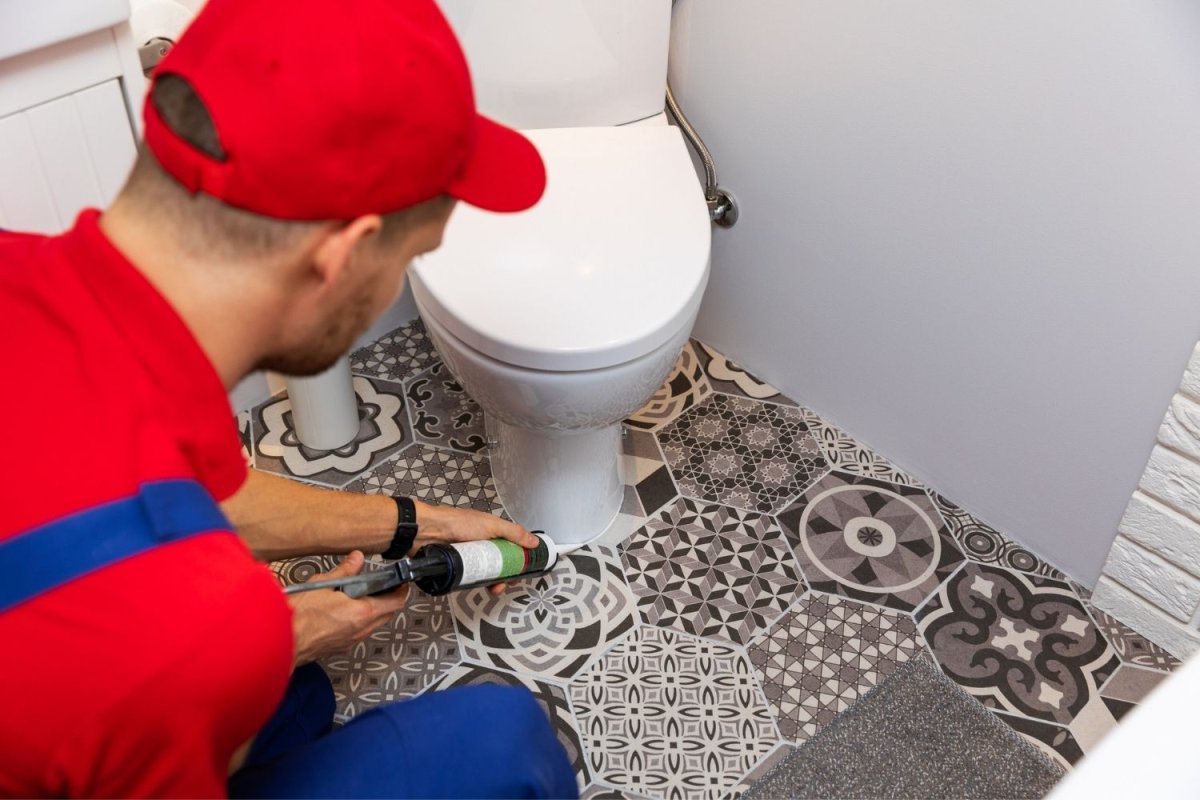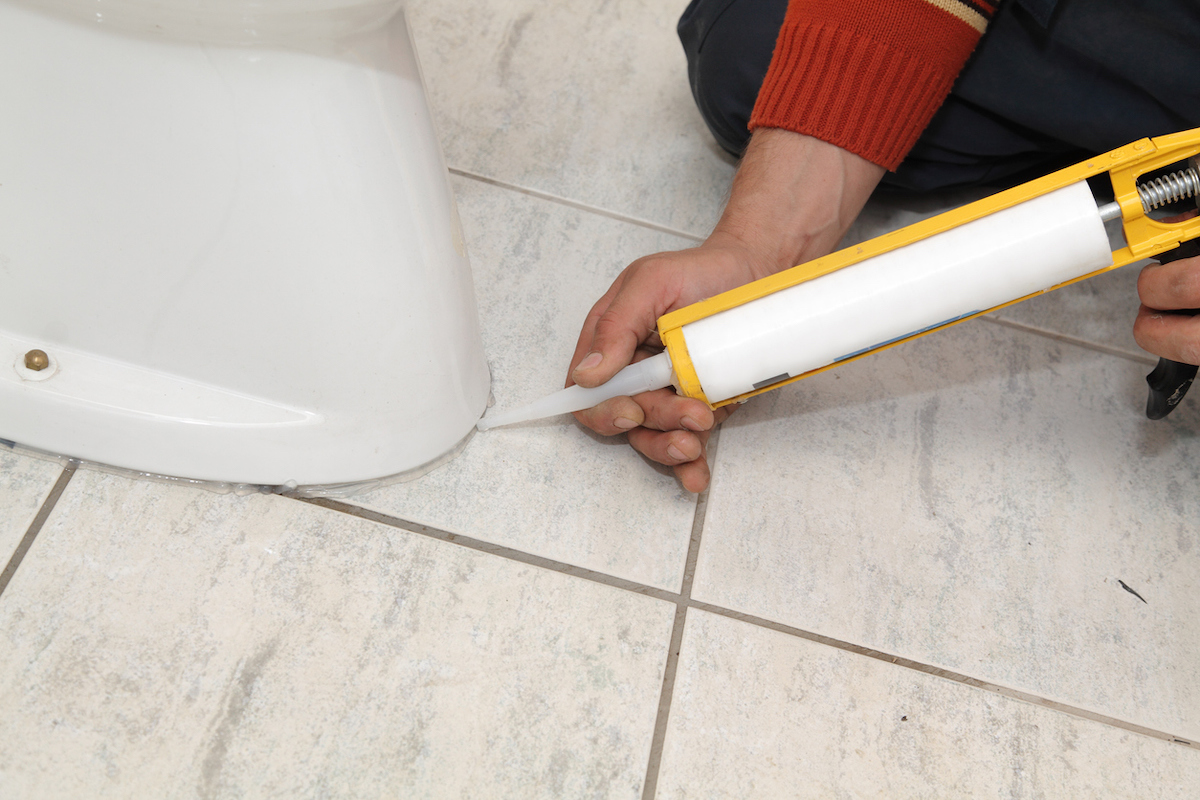

We may earn revenue from the products available on this page and participate in affiliate programs. Learn More ›
When you are putting in a new toilet or reinstalling an existing toilet you will notice that there is a small gap or seam between the base of the toilet and the floor. At this point, you may ask, should you caulk around a toilet to seal this gap? While there are differing opinions about caulking a toilet, it’s generally considered a good idea for a variety of reasons, not the least of which is that it’s required by national and international plumbing code to seal a toilet.
Despite this requirement, some homeowners are concerned that toilet bowl caulking may hide potential leaks, leading to hidden damages tucked away under the toilet, where they can rot out the floor. However, sealing a toilet base doesn’t necessarily mean you need to use caulk, and even if you do caulk the bottom of a toilet, there are different ways to handle this process. Use this guide to learn both sides of this debate, so you can decide for yourself if you should caulk around toilet bases the next time you are upgrading the bathrooms in your home.
Why You Might Not Want to Caulk Around Your Toilet
When you are trying to decide whether to caulk or not caulk a toilet, there are a couple of reasons why some may be in favor of leaving the toilet without caulk. Keep these cautionary concerns in mind when you replace or reinstall your toilet.
Caulking may hide toilet leaks.
The main reason people give for not caulking around toilet bases is that they feel it could hide leaks. If a leak is left undiscovered, the resulting damage could become severe. Without caulk, the leaking water would flow out freely and be noticed right away.
Igor Bystrika, owner and master plumber at Rx Plumbing & Drain, says that “people skip caulking to allow for visible leak detection. Their reasoning is if there’s a wax ring failure or a flange issue, water will often seep out at the base and hopefully be noticed quickly. When the toilet is caulked all the way around, that leak can then get trapped underneath, potentially rotting the floor before anything gets noticed.”
However, leaks are usually noticed from the floor below the toilet when looking up. Leaks under the tub are often found in the same way. In apartments, it is common for the tenant below to be the one who first notices a problem. So this argument for not caulking is somewhat flawed.
Caulking can hide imperfect installations.
When a toilet is not properly installed, it can lead to complications in the future, including leaks, rot, mold, mildew, and terrible odors, so it’s essential to ensure the toilet is installed correctly the first time. However, some DIYers use caulk around a toilet to hide their mistakes.
Bystrika notes that “caulk can hide imperfect installs. If a toilet rocks or sits unevenly, caulk could help stabilize it. However, that’s why it’s best to have a pro install it, so that the toilet sits snug on the floor even without caulk.”
While it isn’t usually a problem to use caulk to cover up very minor imperfections, relying on caulk to help balance a toilet that needs to support weight regularly is a naive decision. Caulk cannot provide the stability necessary to correct serious installation issues, so if you are using it for this purpose, it’s better to hire a plumber to complete the job properly.
Why You Should Caulk a Toilet

In most cases, it’s not just recommended, but also required to caulk around the base of the toilet. As long as the toilet is properly installed, there are many reasons why caulk is a beneficial addition to your toilet installation.
Caulk prevents water from seeping under the toilet.
The same seal that supposedly prevents a leak from being discovered is actually beneficial in that it prevents “external” water from seeping under the toilet. Water splashed out of a shower, tub, or basin, for example, is unable to seep under the toilet if it is properly sealed to the floor.
Bystrika adds that “if you truly want an alternative, a flexible trim or rubber toilet gasket ring can offer a more removable solution that will seal the gap. But to be honest, nothing beats caulk when it’s done right. Just be sure to use a high quality silicone,” such as GE Advanced Silicon Kitchen & Bath Sealant.
If there is no caulk, any water that creeps underneath the toilet can remain undisturbed for some time. It will soon start to stagnate, providing a breeding ground for mold and fungus. The application of caulk to the toilet prevents this from happening, and the bathroom is healthier as a result.
Caulking around the toilet is good for pest prevention.
Water and dirt are not the only substances that may get under the toilet if it is left uncaulked. There are many small pests that find the dark, damp environment ideal for nesting. Bystrika says that “small gaps around a toilet can become great entry points for bugs, especially in older homes.” So when you are caulking the bathroom, Bystrika says he “always recommends caulking the base of a properly installed toilet.”
Caulk looks better and helps prevent unpleasant odors.
In many people’s view, using a caulk gun to apply a clean, white caulk line provides a neat, professional finish. It’s used around wash basins, showers and tubs, and around toilet bases. A dark, uneven join between any of these and the floor looks unfinished by comparison.
There’s also the prevention of unpleasant odors that can sometimes emit from the plumbing and out under the bottom of the toilet. The problem will be made worse if mold or fungus forms under there.
“It gives a clean, finished look and keeps hair, dust, mop water, or urine from getting under the bowl. While a sealed base can help prevent musty smells in a bathroom, especially if moisture tends to collect around the base,” mentions Bystrika.
Plumbing codes require caulking a toilet to the floor.
This is arguably the single most important reason. In most parts of the United States, it is a building code requirement to caulk around toilet bases. This could apply to both new builds and remodeling, though as regulations vary from one state to another it’s a good idea to check local statutes. Bystrika says that “the IPC (International Plumbing Code) requires caulking around the toilet base to prevent water, dirt, or bacteria from getting underneath.”
Professional plumbers generally have the required knowledge and experience. For DIY installers, it may be tempting to skip caulk. Unless inspection is necessary, the homeowner may not consider it worth their time. Although there is potential for a fine, discovery is unlikely until they sell the property. If something is found to meet current building codes, it might put off potential buyers or trigger a more cautious appraisal of the property.
What Kind of Caulk Goes Around a Toilet?
When you are choosing a caulk to apply around the base of the toilet, it’s important to select a product that will hold up, even when exposed to moisture, urine, dirt, grime, bathroom cleaners, and other potential contaminants. The best caulk for the toilet and bathroom is waterproof silicone caulk, such as Gorilla Waterproof Silicone Caulk.
How to Caulk a Toilet
You should plan to recaulk your toilet about once every 5 years or when you notice issues like cracking, peeling, or mold. Caulking around the toilet is not difficult and doesn’t take much time to apply. However, after applying the caulk you will need to wait until it is dry before using the toilet. Follow the simple steps below to caulk a toilet.
- Remove any old caulk with a utility knife or a similar removal tool.
- Clean the toilet base and surrounding floor, then allow the area to dry.
- Load the caulk tube into the caulk gun, cutting the tip at a 45-degree angle.
- Apply a consistent bead of caulk around the toilet base using a pushing motion rather than dragging it, but leave a small gap at the back of the toilet to detect potential leaks.
- Use a damp cloth or your finger to smooth the caulk bead and create a clean, even seal.
- Allow the caulk to dry and cure for the time indicated by the manufacturer.
Final Thoughts
Caulking around the toilet bowl is important to help make a bathroom look clean and finished, while preventing unpleasant odors. While there is a risk of hiding an active leak, if you leave a small gap in the caulk at the back of the toilet, then you have an easy way to handle this concern. Similarly, caulk can be used to hide an imperfect installation, which may lead to leaks or complications in the future.
However, this is all the more reason to ensure that the toilet and the tile around the base of the toilet are properly installed. Applying caulk to a properly installed toilet prevents water, urine, and other contaminants from seeping under the toilet, as well as acting as a barrier for pest prevention. Finally, most national plumbing codes and the International Plumbing Code (IPC) state that the toilet must be properly sealed. So don’t cut corners; caulk around the toilet.
